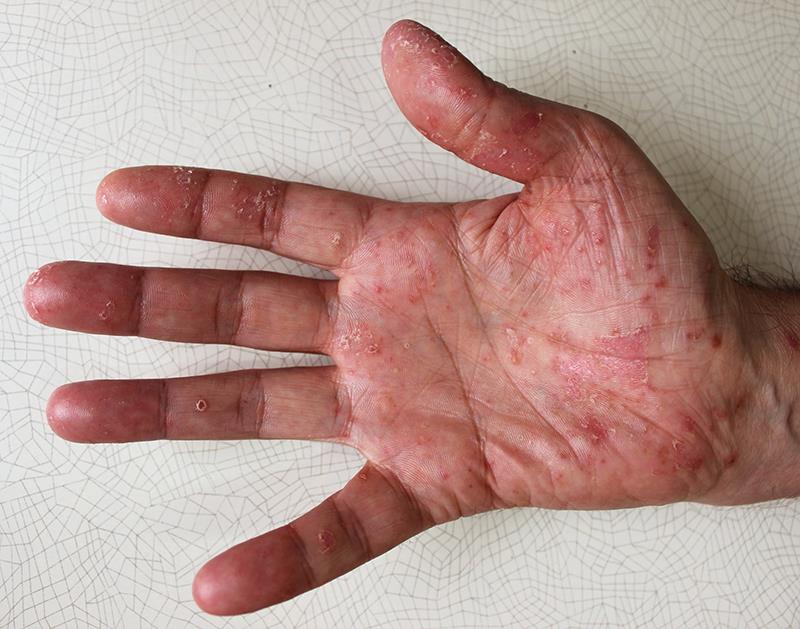Risankizumab eases symptoms in nonpustular palmoplantar psoriasis





In patients with nonpustular palmoplantar psoriasis (nPPP), treatment with risankizumab relieves disease symptoms, such as skin pain in palms or soles of feet, by week 16, as shown by the results of a post hoc analysis of the phase IIIb IMMprint study. These improvements persist up to week 52.
A chronic immune-mediated disease, nPPP “manifests as localized plaques on palms and soles of patients, accompanied by pain that negatively impacts the quality of life,” according to lead author Dr Mark Lebwohl from the Icahn School of Medicine at Mount Sinai, New York, US.
Lebwohl and his team conducted this phase IIIb multicentre, randomized, double-blind, placebo-controlled study to assess the safety and efficacy of risankizumab versus placebo in nPPP patients.
In this post hoc analysis, the research team compared item level results on the Patient Global Assessment of Skin Pain (PGA-SP; measures skin pain on the palms of hands and soles of feet) and Psoriasis Symptom Scale (PSS; measures pain, itching, redness, and burning) between risankizumab and placebo at 16 weeks and improvements through week 52.
Then, Lebwohl and colleagues evaluated treatment outcomes, including change from baseline and achievement of Minimum Clinically Important Difference (MCID) of PGA-S in patients with baseline PGA SP ≥4, as well as the achievement of PSS by individual symptom of 0/1 (PSS 0/1; none/mild for pain, redness, itch, and burning).
Finally, observed cases were used to summarize the long-term (52 weeks) efficacy of risankizumab for continuous pain endpoints.
Overall, 174 patients with nPPP were enrolled and randomized to receive either risankizumab (n=87, mean age 56.9 years, 46.0 percent female) or placebo (n=87, 53.9 years, 51.7 percent female). The mean PSS was 10.5 in the risankizumab arm and 8.9 in the placebo arm, while the mean PGA-SP was 6.8 and 5.3, respectively. [EADV 2004, abstract 4722]
Better than placebo
In patients with baseline PGA-SP ≥4, the change from baseline in PGA-SP at week 16 was ‒3.3 with risankizumab and ‒0.9 with placebo, and at week 52 was ‒4.9 for patients who stayed on risankizumab and ‒4.8 for those who switched to risankizumab from placebo. The percent change from baseline was ‒40.9 percent and ‒9.7 percent at week 16 and ‒62.3 percent and 69.9 percent at week 52, respectively.
At week 16, the proportion of patients who achieved MCID of pain in the palms of hands or soles of feet was 67.2 percent with risankizumab relative to 45.1 percent with placebo. At week 52, this proportion was 70.3 percent for patients who maintained the use of risankizumab and 88.9 percent for those who switched to risankizumab.
PSS 0/1 at week 16 was achieved by 52.1 percent (risankizumab) versus 40.5 percent (placebo) for pain, 49.3 percent versus 25.7 percent for redness, 42.5 percent vs 25.7 percent for itching, and 56.2 percent versus 44.6 percent for burning, respectively.
By week 12, the proportion of patients achieving PSS 0/1 increased to 64.4 percent and 75.4 percent for pain, 61.6 percent and 69.6 percent for redness, 56.2 percent and 68.1 percent for itching, and 65.8 percent and 71.0 percent for burning among patients who stayed on risankizumab therapy and those who switched from placebo, respectively.
“Risankizumab is an approved, interleukin-23 inhibitor targeting the p19 subunit with high affinity and specificity, for the treatment of moderate-to-severe psoriasis, psoriatic arthritis, and Crohn’s disease,” according to Lebwohl.